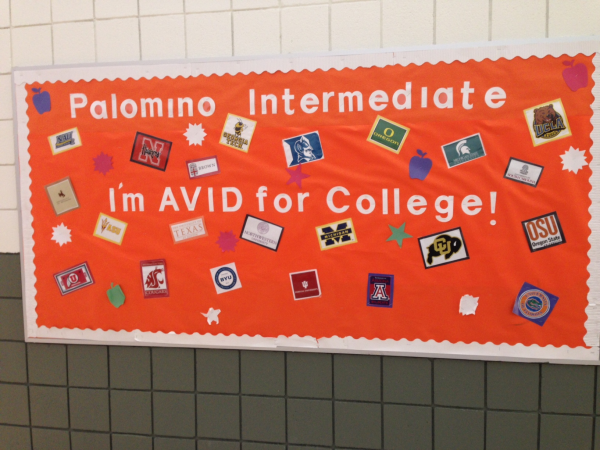
 From the outside looking in, Palomino Intermediate School is a very unassuming building located in central Phoenix. Truth is, there are amazing things happening inside the walls of Palomino, and we were lucky enough to experience them first hand last month.
From the outside looking in, Palomino Intermediate School is a very unassuming building located in central Phoenix. Truth is, there are amazing things happening inside the walls of Palomino, and we were lucky enough to experience them first hand last month.
Palomino serves approximately 470 fourth through sixth graders who live within one square mile area of the school; approximately 40% of the students are English Language Learner students with 100 percent qualifying for Title I funds (free and reduced lunch). Principal Jenny Robles saw opportunity rather than challenge when she first came to Palomino. She and her energetic teachers bring a bright and positive spirit to the halls and classrooms of the school - it’s a place where teachers are excited to be.
Principal Robles arrived at Palomino in January 2008 and at that time the school was underperforming in all aspects. A lot needed to change, and one of the biggest changes that impacted instruction was the implementation of TED video and receiving a grant to purchase the program, Robles decided to send the school’s Instructional Coach, Mr. Bob Moore to California. Moore observed a California school’s implementation of the program and returned to Palomino Intermediate to replicate their success. Moore and Robles dove head first into ST Math and worked to get any and all anticipated concerns and questions answered prior to introducing the program to the teaching staff.
The roll-out began with each teacher spending time in the lab to learn the in’s and out’s of ST Math, the best practices, and the proper way to use the program in order to supplement classroom instruction. Professional development using the blended learning program was a considerable focus from the beginning. Once teachers and staff were trained on the program, Palomino went live and they haven’t looked back. In fact JiJi has become an active component to all classroom instruction. This school-wide integration has helped to create the ideal JiJi culture.
Seeing students so actively engaged and excited about math almost seems too good to be true, but when asked about some of the road blocks or struggles her school experienced, Robles said they were few and far between thanks to having the best of the best when it comes to their teachers.
Mrs. Robles said, “We have teachers with a few months experience to teachers with 40 years experience. They are all extremely enthusiastic and have high expectations for their students’ success. They are a very special group of professionals.”
During our visit we got to see how incredible ST Math truly is. Walking into the computer lab was nothing like walking into a traditional math class where you’d expect to see frustrated students, short attention spans, and mass confusion. The sixth graders we witnessed were so engaged in their individual lessons with JiJi that they hardly noticed us walk in.
ST Math allows students to work at their own pace and gives every student the opportunity to experience success. Students visit the JiJi lab twice a week for 45 minutes. The lab is always staffed with two teachers or one teacher and one para educator. This ensures that students are never stuck for a long period of time which can lead to frustration. All students are required to keep a written math journal to keep track of their accomplishments, questions, and notes along the way.
As the instructional coach, Moore keeps track of the data that ST Math provides and helps articulate it with teachers. Using the data, he works with teachers on placing students in groups for core instruction time based upon skill level and their area of struggle. For example, students who are struggling with fractions would be in one group while those struggling with integers would be in another. This supports teachers’ ability to give more individualized instruction to students even in a large classroom setting and allows for all students to see success.
Every month there is an all-school assembly to recognize math success. The school celebrates ST Math student superstars, and if students reach their next completion goal, JiJi will visit from a different destination around the world, incorporating social studies by sharing adventure stories and fun facts. For example, this month JiJi visited from Brazil and brought along facts about Brazil’s population, size, agriculture, etc.

Professional development is a huge part of building such a strong culture as well as successful blended learning implementation. When Palomino introduced ST Math to their staff, a MIND representative spent a day in the math lab helping teachers and talking them through how to use the program and best practices. In addition, the staff at Palomino meets formally six times a year and often meets informally as well.

Palomino is an exceptional example of creating an education culture focused on success. Everyone is excited to learn and you can feel the energy from teachers and students alike. Each classroom at the school picks a college to research and explore. They follow the school throughout the year and learn more about why college is important and fun, getting students excited about furthering their education.
JiJi is heavily integrated into the culture at Palomino. Every class integrates JiJi into their instruction, and JiJi’s even used as part of the music instruction in the music lab. Walking through the halls of Palomino there’s no mistaking their love for JiJi and ST Math. There are numerous bulletin boards highlighting JiJi’s travels, student growth, and school accomplishments. By integrating JiJi into daily instruction, hiring energetic teachers, using instructional data, staying organized, and creating a positive environment for children, Palomino is helping their students prepare for the next step in their education.

Jessica Slusser is Project Coordinator for Getting Smart, an education advocacy firm. Follow her on Twitter at @Jess_Slusser.

MIND Research Institute welcomes guest blogs that highlight best practices in math education, blended learning and innovative learning strategies that inspire students at all ages.
Comment